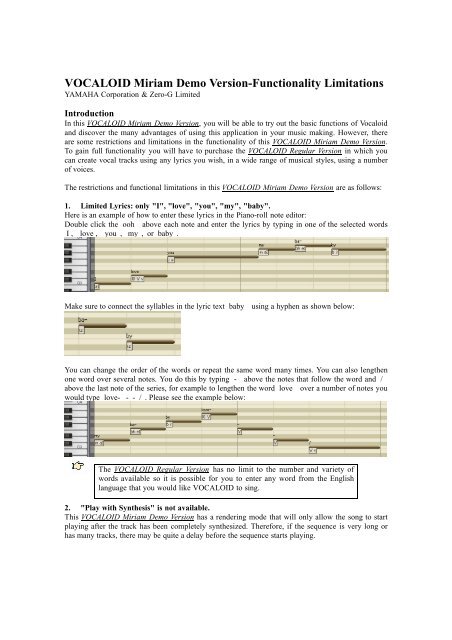

- #Vocaloid editor 4 real time how install#
- #Vocaloid editor 4 real time how software#
- #Vocaloid editor 4 real time how mac#
The VOCALOID software that birthed Hatsune Miku was Japanese conglomerate Yamaha’s early bet on the idea that human voices would one day be as much a part of any amateur musician’s toolbox as a drum sample kit. As humanity hurtles messily into the 2020s - unsure when we’ll next go to a concert - she is paving the way for new conceptions of what modern live music and fandom can achieve, an unconventional pop star whose origin story unknowingly predicted many of the trends and trials the music industry faces today.

Everything else about her, from her image to her music, is built by her millions of adoring fans. Apart from her voice, recorded during development by Japanese voice actress Saki Fujita, she is otherwise totally customizable. And the rising trend of “hologram technology,” a blanket phrase for all kinds of projections popularized when a Tupac facsimile performed at Coachella 2012, literally brings musicians back from the dead for morally dicey nostalgia.īut Miku stands apart from these other virtual figures. Gorillaz, the collaboration between musician Damon Albarn and artist Jamie Hewlett, performs as cartoon characters backed by live musicians. Miku’s not the first virtual musician brought to life by projections. The next logical step: stepping into the real world to grace her fans in the “flesh.” Creators of all skill levels can use her voice technology as an instrument by inputting their own lyrics and melody, which Miku then “sings.” Over the past decade, fans have turned Miku into a bona fide digital pop star: she has almost a million YouTube subscribers and, by one count, she’s the vocalist on at least 100,000 fan-created songs. (In the wake of Coachella’s postponement, the North American leg of the Miku Expo tour has also been rescheduled for the fall.)Īt her crowd-sourced heart, Miku is a voicebank officially “fluent” in Japanese, English, and Mandarin Chinese. This year, she was poised to make a splash on one of Western music’s biggest stages - Coachella 2020. The teal-pigtailed wunderkind, whose name literally means “the first sound of the future,” is a virtual pop star created by Japanese music software company Crypton Future Media. Sixteen-year-old Miku isn’t your typical teen music prodigy. Though she’s been performing for over a decade, she never worries about her evolution in the public eye. She will never be able to drive but she has a dedicated race car team. Miku can’t see the memorabilia, officially licensed or homemade, her devotees wear when they make the pilgrimage to their closest stadium. The Vocaloid Editor for Cubase was updated to version 4.5 with the release of Vocaloid 5.Hatsune Miku doesn’t drink in the roar of her audience, which she commands in the thousands.
#Vocaloid editor 4 real time how mac#
As with the Vocaloid 3 version of the software, those who own this version do not additionally need the normal Vocaloid 4 version of the software and Windows only compatible vocals are incapable of being used with the Mac version. However, it is the only Mac version of the Vocaloid 4 software editor.

This version of the software is can be used by producers on either Windows or Mac. Support continues for the Vocaloid 4 version of the software. The last version of the Vocaloid 3 adaption was 1.0.3 was released on August 5, 2013. As a result, the entire Vocaloid 2 catalog could not be used for the Mac version of Vocaloid Editor for Cubase at all. In regards to its limitations, like Vocaloid Neo the Mac version was limited to being only able to use Mac compatible vocals such as Galaco Neo or VY1v3 Neo.

#Vocaloid editor 4 real time how install#
Though it was designed to work for both Window or Mac, it was only possible to install one version or the other, as is the current case for all Mac versions of Vocaloid. It was later adapted for the Vocaloid Neo version of the Vocaloid 3 software, allowing it to work with Macs. This allowed producers to make music on the go between very different versions of the Vocaloid software for the first time. When Vocaloid Net was officially opened, exchange of data between this version of the software, Vocaloid 3, Vocaloid Neo and iVocaloid were opened up. Those who bought this version of the software did not need to additionally buy Vocaloid 3 or its later Mac version Vocaloid Neo. This means the vocals can be used alongside features such as mixers and buses together smoothly. The advantage of this version, however, is that it is fully capable of working with the Cubase software and utilizing all the features of the Cubase software without fear of compatibility related problems. The software did not come with any new vocals, but was able to impart Vocaloid 2 and Vocaloid 3 engine vocals.


 0 kommentar(er)
0 kommentar(er)
